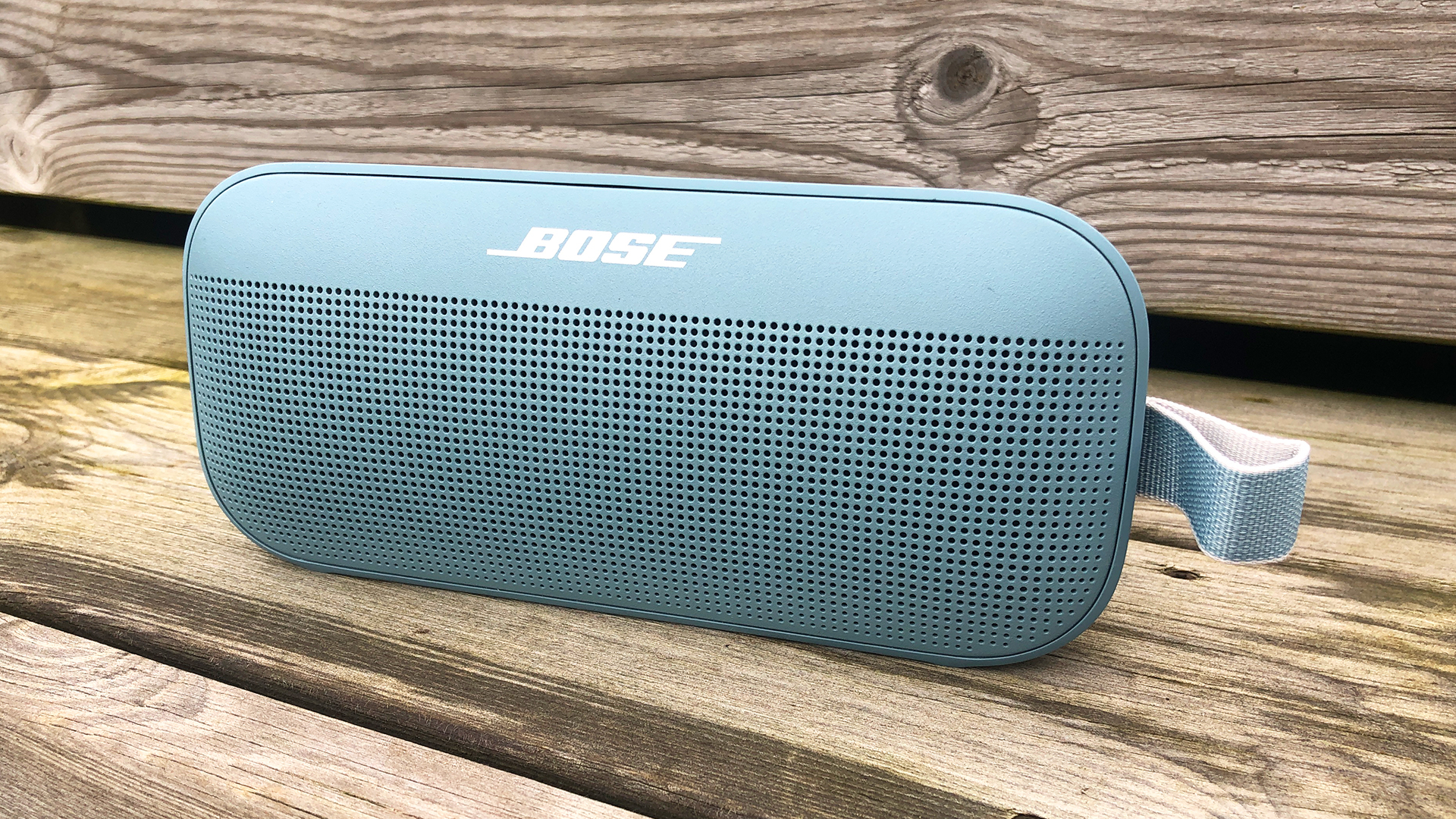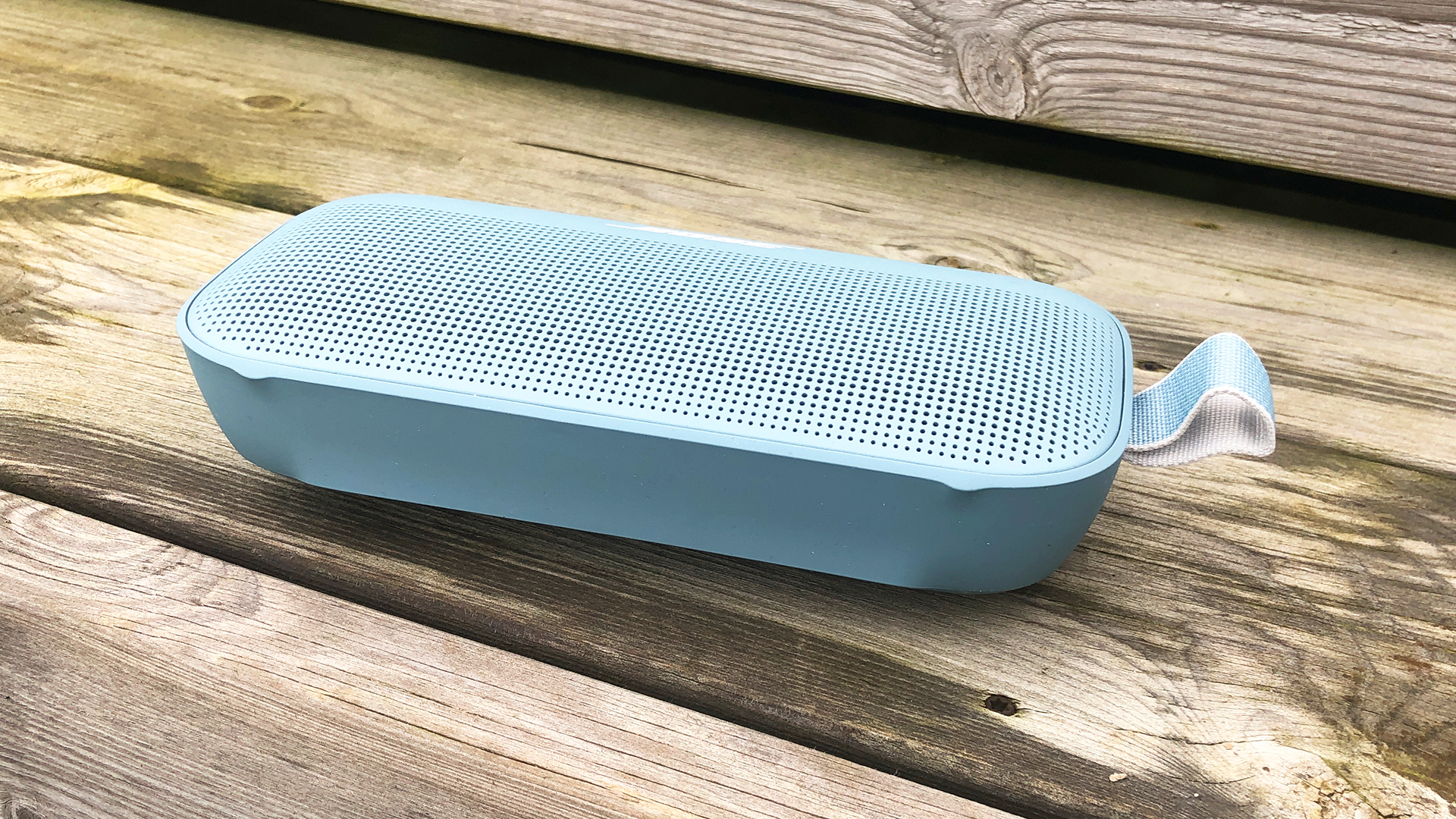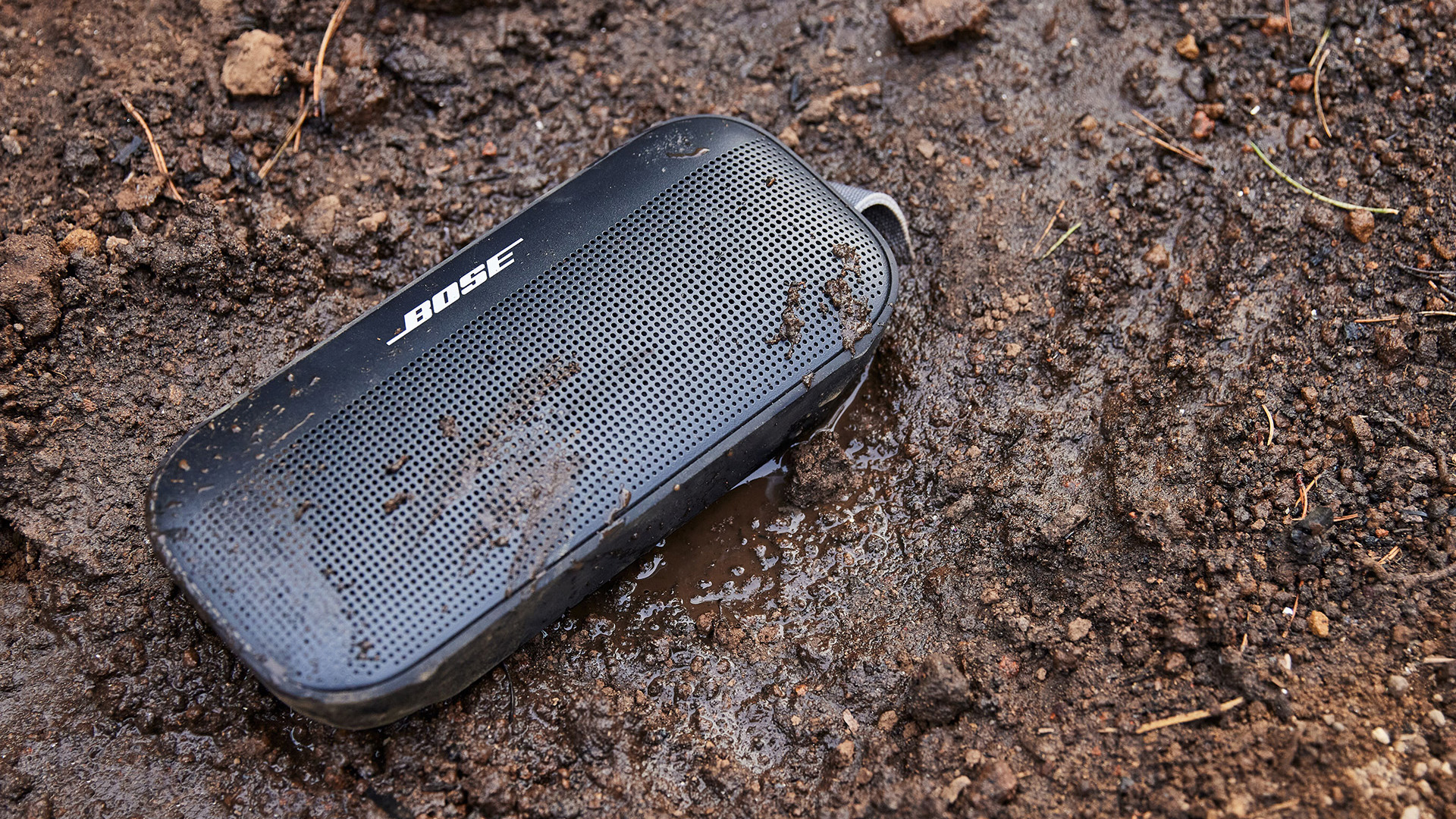Bose SoundLink Flex review: an impressive waterproof Bluetooth speaker
The Bose SoundLink Flex brings powerful sound and a rugged body, but it has tough competition


The Bose SoundLink Flex delivers clear and rich audio, in a suitably tough body with decent battery life. It's not perfect, and it has some hot competition at this price, but it gets more than enough right to warrant consideration.
-
+
Sturdy build and finish
-
+
Expressive, full-scale sound
-
+
Strong battery life
-
-
Bass feels a little detached
-
-
Can be spiky at high volume
-
-
No EQ in app
Why you can trust T3

In this Bose SoundLink Flex review, we're getting our hands, eyes and ears on Bose's newest Bluetooth speaker, which promises great sound in a portable package.
On paper, the Bose SoundLink Flex has everything it needs to compete with the best Bluetooth speakers: decent battery life, rugged and durable construction, decent technical specification and a trustworthy brand's heritage behind it. Its IP67 rating means it's among the best waterproof speakers too – it's ready for outdoors listening whatever the weather (or whatever your clumsiness when standing near a pool).
Happily, the SoundLink Flex delivers overall in the sound department, as you'd expect from Bose – it's surprisingly expansive, and lets a lot of detail shine from your music in a way that portable speakers don't always manage. Paired with the great build quality and nice design, it's a good buy overall – but it doesn't knock the Bang & Olufsen A1 2nd Gen off its spot as our favourite Bluetooth speaker overall.
However, a Bluetooth speaker at this sort of money and this sort of configuration has one rival in particular in its sights: the Sonos Roam. At T3 we find the Roam fits into the ‘good’ rather than ‘great’ category, and the SoundLink Flex is very strong competition for it. Let's dig into the details.
Bose SoundLink Flex: Price & release date
The Bose SoundLink Flex was released in October 2021 in the US, and December 2021 in the UK.
In the UK, it sells for pennies less than £150. In the United States (where Bose is, if anything, an even bigger deal than it is in the UK) it’s yours for an aggressive $149, while customers in Australia will have to part with AU$199 or so.
Obviously you’re not exactly short of options where products like this, at this sort of price, are concerned. As well as the disconcertingly successful Sonos Roam, you’ve very viable alternatives from the likes of Bang & Olufsen, JBL and Ultimate Ears to consider - and there are a stack of slightly lower-profile competitors available too. So Bose really shouldn’t be taking anything for granted.
Get all the latest news, reviews, deals and buying guides on gorgeous tech, home and active products from the T3 experts
Check our Bose discount codes for a great deal.

Bose SoundLink Flex: Features & what's new
The SoundLink range has been up and running for a good while now, but Flex itself is an all-new design that doesn’t share much except a big, bold logo with other members of the range. Visually, it’s closest to 2017’s SoundLink Micro – but a bit bigger, naturally.
Specification is a mixture of ‘thoughtful and impressive’ and ‘rather disappointing’. On the plus side, the 12 hours of battery life claimed by Bose is easily achievable as long as you’re not cranking the volume way up – and connecting the Flex to the wall via its USB-C input will take it from ‘flat’ to ‘full’ in around 150 minutes.
The driver array consists of a single full-range dynamic driver, supplemented by a couple of ‘racetrack’ passive radiators that promise greater bass presence that might at first glance seem likely. And Bose’s ‘PositionIQ’ technology (which is a fancy-pants way of describing accelerometers) means the Flex will automatically optimise its sound depending on the way it’s oriented.
Certainly not in the ‘plus’ column is wireless connectivity via Bluetooth 4.2 – it’s hardly a disaster, but if you’re paying for a top-tier streaming service subscription it might be nice to be able to listen to their highest hi-res files on your nice new portable speaker. Mightn’t it? Still, at least the Bose can support two Bluetooth connections at once, which is useful for simple switching between devices.
As with the size and composition of the drivers, and the type and resolution of the DAC, Bose is coy in the extreme where the details of the Flex’s amplification are concerned. That it’s Class D is a very safe bet, but as to how much actual power it generates, well, that information is not for the likes of us. But, just as with the details of the DAC, spend enough time listening to the Bose and it’ll become apparent before too long that it's packing enough grunt.

Bose SoundLink Flex: Sound quality
There’s no facility to adjust the EQ settings of the SoundLink Flex, so the sound you get is the sound you’re given. Happily, in many ways that’s a perfectly agreeable arrangement.
Streaming from TIDAL reveals no small amount of punch and drive. Given its modest dimensions, the Bose is capable of quite unlikely scale of sound – obviously the company’s claims of ‘room-filling sound’ are a false alarm for anything bigger than a bedroom, and you’ll never be in any doubt as to the direction the sound is coming from, but the Flex nevertheless sounds bigger than it actually is.
Unlike a lot of designs that use a single driver to cover the entire frequency range, the SoundLink Flex has good presence and bite at the top end: its treble reproduction is crisp and well-defined, but doesn’t get in any way hard even at big volumes. There’s a tiny suggestion of sibilance when playing treble-happy recordings, but while that’s not ideal it’s certainly preferable to the dull, rolled-off top-end response of many other similarly specified speakers.
The opposite end of the frequency range is equally well represented – thanks, no doubt, to that pair of passive radiators. The lowest frequencies can sound just a little monotonal and a little detached, it’s true, but (again) it’s preferable to any number of alternatives. With a little more detail and a little more certainty where timbre and texture are concerned, the Flex would be one of the best portable speakers around where this sort of thing is concerned. It's still among impressive company as it is.
The midrange is similarly impressive within similar parameters. It projects well, letting vocalists present themselves ahead of the information surrounding them, and while it can get just a little edgy in extremis, it carries enough detail to grant a singer worthwhile character and expression.
The rather remote nature of the lowest frequencies aside, integration of the frequency range is as smooth as it should be when it’s all being delivered by the same driver. Whatever the power rating of the Flex’s amplification, it breathes deeply enough to express dynamic shifts with something approaching relish.
And when given some properly rhythm-orientated files to handle, it demonstrates a very pleasant facility with rhythmic expression – which would be even more impressive if the lowest frequencies could be persuaded to properly join in with the rest of the music.

Bose SoundLink Flex: Design & usability
The SoundLink Flex is a reasonably compact 20x9x5cm and weighs a very manageable 600g – which covers off ‘portability’ nicely. It has an extremely sturdy fabric strap at one end of its chassis, too, which means it can happily hang off a hook or a bag. And the materials used – mostly soft-touch silicone with powder-coated steel face-plate and grille – mean the Flex has an IP67 rating against dust and moisture ingress. In fact, those owners brave enough to try will find their SoundLink Flex will float quite happily in water.
There are black, ‘white smoke’ and ‘stone blue’ finishes available, all of them quite self-consciously grown up when compared to some of the rather more vivid finishes offered by the likes of Ultimate Ears. And the chassis features little moulded feet to allow the Bose to lie on its back or stand up in ‘landscape’ orientation.
As far as usability goes, the Flex is properly, well, flexible. Along the top of the frame of the speaker (assuming you have it standing upright) there are controls for ‘power on/off’, ‘Bluetooth pairing’, ‘volume up/down’ and a multi-function button covering ‘play/pause’ and ‘skip forwards/backwards’. There’s also the ability to use Google Assistant or Siri for voice control.
Or you could give the Bose Connect app a go – it’s classic Bose, inasmuch as it’s clean, stable, good-looking and not really all that much use. Certainly the lack of EQ adjustment will rankle with any number of users. At least it’s possible to form a stereo pair using the Flex and another Bose speaker within the app, though.
One area where the SoundLink Flex scores over pretty much any nominal rival is the speed and solidity of its Bluetooth connectivity. Turn on the Bose and it immediately informs you of its battery status, and then very quickly confirms a Bluetooth connection.

Bose SoundLink Flex: Verdict
Where the Bose SoundLink Flex is good, it’s very good indeed – so as far as resilience, longevity and portability are concerned, it’s among the genuine front-runners.
There are unarguable positives to its sound, too, not least its full-range response and the assertive nature of its lower frequencies. Some other designs do a better job where frequency integration and detail retrieval are concerned, though… which means the Flex is a good option among the top speakers of its type rather than a compulsory purchase.
Make sure you head to our Bose discount codes to grab a saving.
Bose SoundLink Flex: Also consider
Our favourite portable Bluetooth speaker costs a chunk more than the Bose SoundLink Flex, but we reckon the Bang & Olufsen Beosound A1 v2 is absolutely worth the extra outlay. It’s a little lighter than the Bose, its battery lasts a little longer, and it delivers even better audio quality than the Flex. That’s why it won the T3 Award in this area last year, and remains top of our list. Here's our full five-star B&O Beosound A1 2nd Gen review.
Another B&O option worth considering is the Explore tough speaker, which is closer to the price of the Bose, is slightly more compact than the Flex or the A1, and has a very funky (and supremely tough) cylinder design. Its 27-hour battery life is huge step up over the Bose, but its sound quality is lower – it's lacking in bass punch especially. A great alternative to get you through a whole weekend of hiking, but maybe not as good an option for garden listening. Here's our full Bang & Olufsen Explore review.
Finally, the Sonos Roam is also worth consideration. Again, it's a tough portable speaker of around the same price as the Bose. You get slightly lower battery life, and quite a bass-forward sound presentation – music purists will probably prefer the Bose. But it also includes Wi-Fi and works as part of a Sonos or AirPlay 2 multi-room setup, so is a bit more flexible for home listening in that regard. Here's our full Sonos Roam review.
Simon Lucas is a freelance technology journalist and consultant, with particular emphasis on the audio/video aspects of home entertainment. Before embracing the carefree life of the freelancer, he was editor of What Hi-Fi? magazine and website – since then, he's written for titles such as Wired, Metro, the Guardian and Stuff, among many others. Should he find himself with a spare moment, Simon likes nothing more than publishing and then quickly deleting tweets about the state of the nation (in general), the state of Aston Villa (in particular) and the state of his partner's cat.
